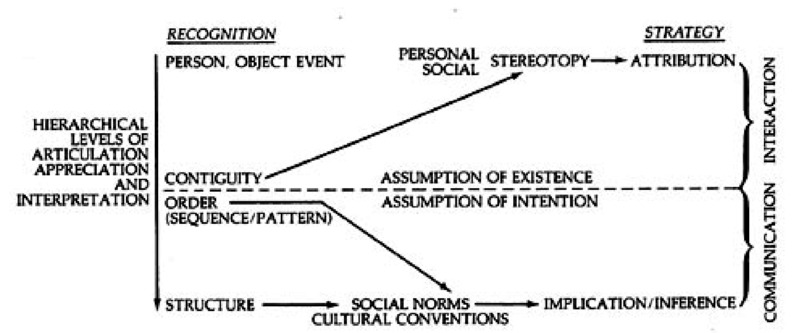-
Title
-
Competence to Perform in a Communications Event
-
Description
-
Let us now turn to the question of how people develop the competence to assess and interpret symbolic intent. The distinctions in [the Figure] are meant to explain, not an ideal state of knowledge or competence, but the actual use of certain abilities in the articulation and interpretation of meaning in communication situations.
We learn to articulate in a variety of symbolic modes and codes, as we similarly learn to interpret in an appropriate set of ways. As Gross has shown, the competence to perform (either as creator or interpreter) is dependent upon the acquisition of at least minimal articulatory ability in that mode (1974).[The Figure] diagrams what we are hypothesizing as a model of the levels of articulatory and interpretive abilities and indicates a series of recognition stages that people apply to sign-events. These stages or levels are seen as both developmental and hierarchical. … The process we envisage is one of elaboration rather than replacement, much like the progression from crawling to walking. Once we learn to walk, we do not lose the ability to crawl. Once we have learned to recognize at all levels, we can choose our strategies depending upon our assessment of the sign-event situation.
-
Designer
-
Worth, Sol
-
Gross, Larry
-
Date
-
1974
-
Source
-
"Symbolic Strategies"
-
Bibliographic Citation
-
Worth, Sol and Larry Gross. 1974 "Symbolic strategies." In Studying Visual Communication (1981), by Sol Worth. Edited, with an Introduction, by Larry Gross. University of Pennsylvania Press. Figure 5-2. page 138-139.
-
Worth, Sol and Larry Gross. 1974 "Symbolic Strategies." Journal of Communication. 24:27-39.
-
is depiction of attribute
-
English
Square
-
has attribute
-
English
Arrow
-
English
Dash Line
-
English
Solid Line
-
use feature
-
English
Brace
-
depict things of type
-
English
Sequence or Process
-
English
Typological or Classification
-
Coverage
-
communication
-
semiotics

